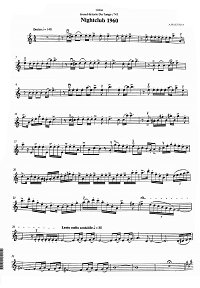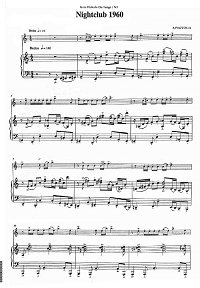Piazzolla - Nightclub 1960 for violin and piano
Piazzolla - Nightclub 1960 for violin and piano . You can download the PDF sheet music Piazzolla - Nightclub 1960 for violin and piano on this page. In 1986 famed guitarist Roberto Aussel commissioned the "Histoire du Tango". which represented a challenge, in that it was Piazzolla's first piece written for guitar. It is a suite of four pieces, roughly suggesting the tango's development over a hundred-year period from the year 1900. Here you can find the violin and piano version of N3: Night-Club 1960. The international post-war era is evoked in this lively piece, which illustrates the influences of other dance forms, such as the bossa nova. Nightclubs became a focal point for tango music during this era. and the form changed dramatically.
In the 1950s Piazzolla traveled to Paris to study with famed composition teacher Nadia Boulanger, who directed him toward what would become his signature compositional style: the tango, shaped through both classical and jazz styles. Once back in Argentina, the experience in Paris proved the key to unlocking his future: his "modernist" tango music became immensely popular, despite opposition from traditionalists.
To download PDF, click the "Download PDF" button below the appropriate sheet music image.
To view the first page of Piazzolla - Nightclub 1960 for violin and piano click the music sheet image. |
| PDF format sheet music |
|
|
|
Violin part: 3 pages. 433 K
|
Piano part: 10 pages. 1343 K
|
 |
 |
|
|
| Download PDF (14.99
€) |
Download PDF (14.99
€) |
|
This movement combines the better of first two movements. It possesses both the flashy and rhythmic elements as well as the slower, more expressive sections. It begins with a tempo marking of deciso, meaning “with determination.” In bars 25-26, there is a rallentando that leads up to the first lento section in bar 27. Markings such as molto cantible and tristemente indicate that the violinist must play as if singing a very mournful song. While it is indicated that the duo play a bit heavier, pesante, in measure 36, the slow and melancholy mood is to be carried out until measure 54, where the duo arrives back at Tempo I. This section is compelling in that the violinist can choose to perform it in a variety
of ways, depending on their ability and creativity. |
|